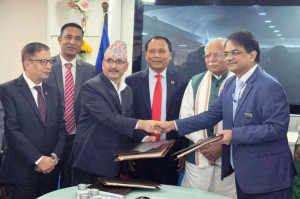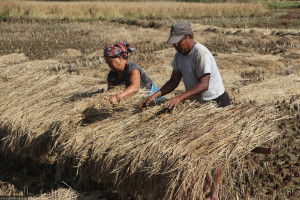Money
Indian sugarcane hitting Nepali farmers’ income
Sugarcane farmers of Nawalparasi district are being affected by the massive inflow of Indian sugarcane which enter the country via the porous border. This means that Indian sugarcane avoid paying customs duty and is priced lower than Nepali farmers produce.
Nabin Poudel
Sugarcane farmers of Nawalparasi district are being affected by the massive inflow of Indian sugarcane which enter the country via the porous border. This means that Indian sugarcane avoid paying customs duty and is priced lower than Nepali farmers produce.
The poor farmers of the district are then forced to sell their produce at a cheaper rate in order to compete with the Indian sugarcane. Due to apathy shown by the security forces of both countries, more than 50 tractors loaded with sugarcane are entering Nepal daily.
Although the price of sugarcane is the same in both countries, owners of sugarcane crushers in Nawalparasi district prefer sugarcane from the neighbouring country as Indian farmers offer cash discount.
On the other hand, Nepali farmers are forced to sell their produce to middle men as it is difficult to reach the sugar mill located on the other side of the Narayani River in absence of motorable bridge.
A few farmers take the risk and use boats to transport their produce to sugar mill. But, after completing the boat journey, they have to load their produce onto tractors to transport it to the mill, making the transportation cost higher. As a result, Nepali sugarcane farmers are forced to sell their produce at prices lower than the ones fixed by the government.
Normally, sugar producers determine sugarcane prices based on the rates prevailing in India. The price of Indian cane has decreased to IRs200 per 100kg from last year’s IRs300 per 100kg.
“The local administration must take immediate action to stop inflow of Indian sugarcane otherwise our survival will be at stake,” said Umesh Yadav, president of Sugarcane Producers Committee of Nawalparasi. “They should stop the Indian sugarcane at the border.”
Fed up with the lower price fetched by their produce, sugarcane growers have been switching to cultivating other crops. This is evident as the number of farmers involved in sugarcane cultivation have seen a noticeable reduction in the past few years.
There were 14,000 sugarcane farmers involved in cane cultivation until few years ago, which has dropped to 7,000 currently, according to the association. Likewise, the annual output has also dropped significantly. Sugarcane mills used to receive 4 million quintals for crushing, which has halved in the last few years. There are three sugar mills — Lumbini, Bagmati and Indira — in the district that requires 2.5 to 3 million quintals of sugarcane. In 2002, the district’s sugarcane production reached its peak at 4.2 million quintals.
The production dropped to 2.3 million quintals last year.
The production ‘command area’ of the crop has dropped to 5,000 hectares this year, from 7,000 hectares last year, according to the association. Nepal produced 3.13 million tonnes of sugarcane in 2015-16. Sugarcane farming occupied 72,730 hectares of land in 2015-16, according to government statistics.




 16.12°C Kathmandu
16.12°C Kathmandu













